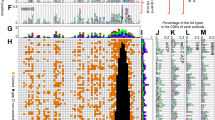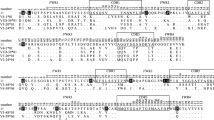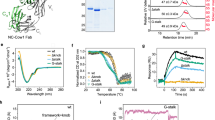Abstract
The variable domains of an antibody consist of a β-sheet framework with hypervariable regions (or complementarity-determining regions—CDRs) which fashion the antigen-binding site. Here we attempted to determine whether the antigen-binding site could be transplanted from one framework to another by grafting the CDRs. We substituted the CDRs from the heavy-chain variable region of mouse antibody B1–8, which binds the hapten NP-cap (4-hydroxy-3-nitrophenacetyl caproic acid; KNP-cap = 1.2 µM), for the corresponding CDRs of a human myeloma protein. We report that in combination with the B1–8 mouse light chain, the new antibody has acquired the hapten affinity of the B1–8 antibody (KNP-cap = 1.9 µM). Such ‘CDR replacement’ may offer a means of constructing human monoclonal antibodies from the corresponding mouse monoclonal antibodies.
This is a preview of subscription content, access via your institution
Access options
Subscribe to this journal
Receive 51 print issues and online access
$199.00 per year
only $3.90 per issue
Buy this article
- Purchase on Springer Link
- Instant access to full article PDF
Prices may be subject to local taxes which are calculated during checkout
Similar content being viewed by others
References
Poljak, R. J. et al. Proc. natn. Acad. Sci. U.S.A. 70, 3305–3310 (1973).
Segal, D. M. et al. Proc. natn. Acad. Sci. U.S.A. 71, 4298–4302 (1974).
Marquart, M., Deisenhofer, J., Huber, R. & Palm, W. J. molec. Biol. 141, 369–391 (1980).
Kabat, E. A., Wu, T. T., Bilofsky, H., Reid-Miller, M. & Perry, H. in Sequences of Proteins of Immunological Interest (U.S. Department of Health and Human Services, 1983).
Lesk, A. M. & Chothia, C. J. molec. Biol. 160, 325–342 (1982).
Chothia, C., Novotny, J., Bruccoleri, R. & Karplus, M. J. molec. Biol. 186, 651–663 (1985).
Reth, M., Hämmerling, G. J. & Rajewsky, K. Eur. J. Immun. 8, 393–400 (1978).
Saul, F. A., Amzel, M. & Poljak, R. J. J. biol. Chem. 253, 585–597 (1978).
Brüggemann, M., Radbruch, A. & Rajewsky, K. EMBO J. 1, 629–634 (1982).
Reth, M., Bothwell, A. L. M. & Rajewsky, K. in Immunoglobulin Idiotypes and Their Expression (eds Janeway, C., Wigzell, H. & Fox, C. F.) 169–178 (Academic, New York, 1981).
Neuberger, M. S. & Rajewsky, K. Proc. natn. Acad. Sci. U.S.A. 78, 1138–1142 (1981).
Neuberger, M. S. et al. Nature 314, 268–270 (1985).
Bothwell, A. L. M. et al. Cell 24, 625–637 (1981).
Mulligan, R. C. & Berg, P. Proc. natn. Acad. Sci. U.S.A. 78, 2072–2076 (1983).
Fersht, A. R. et al. Nature 314, 235–238 (1985).
Fersht, A. R., Wilkinson, A. J., Carter, P. & Winter, G. Biochemistry 24, 5858–5861 (1985).
Boyd, J. E., James, K. & McClelland, D. B. L. Trends Biotechnol. 2, 70–77 (1984).
Shawler, D. L., Bartholomew, R. M., Smith, L. M. & Dilman, R. O. J. Immun. 135, 1530–1535 (1985).
Morrison, S. L., Johnson, M. J., Herzenberg, L. A. & Oi, V. T. Proc. natn. Acad. Sci. U.S.A. 81, 6851–6855 (1984).
Boulianne, G. L., Hozumi, N. & Shulman, M. J. Nature 312, 643–646 (1984).
Reth, M., Imanishi-Kari, T. & Rajewsky, K. Eur. J. Immun. 9, 1004–1013 (1979).
Eisen, H. N. Meth. med. Res. 10, 115–121 (1964).
Mariuzza, R. A. et al. J. molec. Biol. 170, 1055–1058 (1983).
Segal, I. H. in Enzyme Kinetics, 73–74 (Wiley, New York, 1975).
Jones, T. A. in Computational Crystallography (ed. Sayre, D.) 303–310 (Clarendon, Oxford, 1982).
Staden, R. Nucleic Acids Res. 12, 521–538 (1984).
Sanger, F. & Coulson, A. FEBS Lett. 87, 107–110 (1978).
Yanisch-Perron, C., Vieira, J. & Messing, J. Gene 33, 103–119 (1985).
Sanger, F., Nicklen, S. & Coulson, A. R. Proc. natn. Acad. Sci. U.S.A. 74, 5463–5467 (1977).
Messing, J. & Vieira, J. Gene 19, 269–276 (1982).
Flanagan, J. G. & Rabbitts, T. H. EMBO J. 1, 655–660 (1982).
Neuberger, M. S., Williams, G. T. & Fox, R. O. Nature 312, 604–608 (1984).
Author information
Authors and Affiliations
Rights and permissions
About this article
Cite this article
Jones, P., Dear, P., Foote, J. et al. Replacing the complementarity-determining regions in a human antibody with those from a mouse. Nature 321, 522–525 (1986). https://doi.org/10.1038/321522a0
Received:
Accepted:
Issue Date:
DOI: https://doi.org/10.1038/321522a0
This article is cited by
-
Structural basis of spike RBM-specific human antibodies counteracting broad SARS-CoV-2 variants
Communications Biology (2023)
-
Designing stable humanized antibodies
Nature Biomedical Engineering (2023)
-
Advances in antibody-based therapy in oncology
Nature Cancer (2023)
-
Predicting the Social-Emotional Competence Based on Childhood Trauma, Internalized Shame, Disability/Shame Scheme, Cognitive Flexibility, Distress Tolerance and Alexithymia in an Iranian Sample Using Bayesian Regression
Journal of Child & Adolescent Trauma (2023)
-
Crystal structure of ultra-humanized anti-pTau Fab reveals how germline substitutions humanize CDRs without loss of binding’
Scientific Reports (2022)
Comments
By submitting a comment you agree to abide by our Terms and Community Guidelines. If you find something abusive or that does not comply with our terms or guidelines please flag it as inappropriate.



